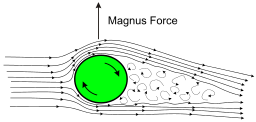Magnus Effect on a Cylinder
Tags | |
UUID | 7bf636d7-2cdc-11e5-a3bb-bc764e2038f2 |
The Magnus Effect on a Cylinder calculator computes the force on a cylinder due to the Magnus Effect. The Magnus Effect is the effect most commonly known to create the curved path of a sports ball, such as a golf ball, volleyball, or baseball.
INSTRUCTIONS: Choose your preferred units and enter the following:
- (V) Velocity that the rotating object compared to the surrounding medium (air or fluid).
- (?) Density of the medium (e.g. ? = 1.28 kg/m3 for air)
- (r) Radius of the cylinder
- (?) Rotation rate of the cylinder
- (L) Length of the cylinder
Magnus Effect: The calculator computes the force of the Magnus Effect in Newtons (N). However, this can be automatically converted into other force units (e.g. dynes or pound force) via the pull-down menu. To look up the mean density of a substance, CLICK HERE.
Related Calculators
- Volume of a Cylinder
- Mass of a Cylinder
- Surface Area of a Cylinder and Flettner aeroplanes, where the rotating surface is a cylinder instead of a ball.1
To understand the physics behind the Magnus effect we consider the conservation of momentum and the fact that the force on the body is approximately the equal and opposite force that the body imposes on the air flow around it, an expression of Newton's Third Law of motion. An upward lift force is created by a total summed deflection of the wake in the air flow downward.
Sketch of Magnus effect with streamlines and turbulent wake,
Wikipedia / Rdurkacz
CC BY-SA 3.0
For a rotating cylinder, the lift force is due to the angular deflection of the turbulent "wake" behind the moving cylinder. This can be visualized as the wake behind a moving cylinder (which creates aerodynamic drag) experiencing a noticeable angular deflection in the direction of the rotation of the cylinder. This is shown in the picture to the right. Notice that the cross-sectional view of the fluid flow in this diagram traces a contours very similar to the airflow over a airplane wing.
In the case of a spinning baseball, lift is produced on a back-spinning ball when the turbulent wake trailing the ball is deflected downwards. The rotation of the ball causes the boundary layer motion to be more turbulent beneath the ball where the rotation of the ball's surface is forward.
DERIVATION
On a cylinder, the force due to rotation can be defined in terms of the vortex produced by rotation. This force is also known as Kutta-Joukowski lift. The lift force per unit length on a cylinder is and is the product of the velocity, (in metres per second), the density of the fluid, (in kg per cubic meters), and the strength of the vortex that is established by the rotation, .
`G = ( (2*Pi * r)2 ) * ssr` is the radius of the cylinder.
See Also
Equations and Data Items
Collections
- Comments
- Attachments
- Stats
No comments |
